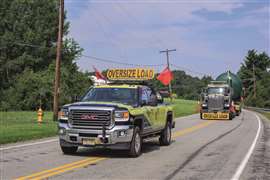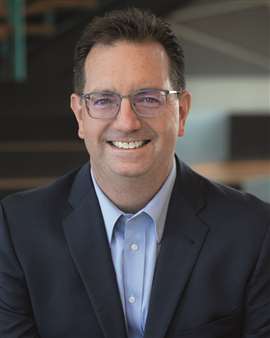SC&RA debuts best-practice guide for carriers and pilot cars
28 February 2024
A few years ago, strengthened by ongoing discussions at SC&RA’s Pilot Car Committee meetings and many additional conversations that followed, it became clear that a concern was growing over a disconnect between carriers and pilot car services in both the U.S. and Canada.
 SC&RA’s new best-practice guide for carriers and pilot cars was designed to bring together a common understanding of what roles and responsibilities are within a specialized move, and what it means to be part of the process. The guide is a free resource for members. PHOTO: Julian Leek
SC&RA’s new best-practice guide for carriers and pilot cars was designed to bring together a common understanding of what roles and responsibilities are within a specialized move, and what it means to be part of the process. The guide is a free resource for members. PHOTO: Julian Leek
In fact, various SC&RA members pointed to a specific, and troubling, trend where both carriers and pilot car companies were not performing pre-trip safety meetings as a best practice.
“We started examining this issue and realized that there were a lot of moving pieces,” explained SC&RA Vice President, Transportation Chris Smith. “You start to unravel the whole process of the pilot car industry, how it ties into the permit process, the regulatory process, and there’s a lot to unpack.”
Smith and additional Association members put together a joint task force between the Pilot Car Committee and the Transportation Group Safety Education and Training Committee to identify the elements of a proper pre-trip meeting as well as all the different roles, relationships and responsibilities involved in a trip on any given day.
“We realized that there seems to be a significant lack of common understandings of safety protocols between drivers of both carriers and pilots,” Smith pointed out. “There are questions around communication, law enforcement involvement, driving through small towns, utility moves. A lot of coordination. Many of these roles and responsibilities aren’t always fleshed out – which then starts to really impact risk-mitigation, legal liabilities, insurance, etc.”
It didn’t take long for everyone involved in the task force to realize that the industry was in need of an updated and highly comprehensive document.
“The Federal Highway Administration put out best practice guidelines and a training manual for pilot cars in 2004 and 2017, with assistance from SC&RA,” noted Smith, “but they focus mainly on the pilot car side. WITPAC [Wind Industry Transportation Professional Advanced Certification] also has a curriculum, though it is specific to the wind industry. And there are plenty of other concepts out there, including many sophisticated in-house standards used by SC&RA members and others in the industry.”
 Ongoing discussions at SC&RA’s Pilot Car Committee and within additional conversations have revealed a growing concern over the disconnect between carriers and pilot car services in both the U.S. and Canada.
Ongoing discussions at SC&RA’s Pilot Car Committee and within additional conversations have revealed a growing concern over the disconnect between carriers and pilot car services in both the U.S. and Canada.
Smith and the committee members decided to tap into as much of that available knowledge as possible and develop a resource for everyone involved on a heavy-haul trip, with an emphasis for carriers.
What emerged is the “Best Practices for Specialized Motor Carriers in Qualifying, Selecting, and Utilizing Pilot/Escort Vehicle Operator Services” guide, which Smith is excited to have available for SC&RA members as a free resource this month, debuting at the Specialized Transportation Symposium in Houston, Texas, February 20-22.
“We reached out to carriers and pilot car companies alike and asked them, what are your best practices?” he added. “It all went into this guide – everything from the planning process to insurance to risk mitigation, right up to what you do the day you hit the road.”
Positive impact
Louis Juneau, with NOVA Permits & Pilot Cars, was part of the early discussions on the disconnect between carriers and pilots, and as part of the task force at the time, saw the conversation evolve up to the committee level.
 Louis Juneau, NOVA Permits & Pilot Cars
Louis Juneau, NOVA Permits & Pilot Cars
“At the root of it, it’s about making the industry safer,” he emphasized. “Unfortunately, it seems like there are still a lot of carriers out there who just don’t care. I deal with it regularly both here in Canada and in the States – where a truck driver will tell a pilot car driver, ‘I don’t want to see or hear you – you’re just a requirement on my permit.’ Still, others might put a lot of responsibility on the pilot car.”
Juneau pointed to economics as part of the problem. “Money talks louder than safety a lot of the time, sadly,” he indicated. “When some carriers get behind on schedule, and they’ve got thousands of dollars in penalties if they don’t deliver on time, well guess what? The pre-trip briefing lasts five minutes instead of thirty. And who cares about the pole-height measurement – let’s get this show on the road. And that’s where issues often arise.”
Nick Ruscito-Caissy, president and CEO at ODS North America, as well as SC&RA Pilot Car Committee chair, agreed. “I also feel that over the years, an us-versus-them mentality has begun to emerge, and this document really helps to confront that issue by defining roles very well.”
Ruscito-Caissy believes that by putting the cards on the table, in a sense, the new guide will bring people together under a common understanding. “My job is this, your job is that, and now let’s work together because we have a common goal,” he said. “And within that goal, we each have our distinctive responsibilities. A lot has changed in the last ten to fifteen years, as far as rules and regulations, but also the loads that are being moved have changed. The roles of a pilot car have changed. So this is a back-to-the-basics look for everyone involved – and what it means to be a part of this process.”
He also sees the guide having tremendous value from an insurance standpoint. “Everyone will understand what their roles are. They can be better equipped to focus on their particular job and let the other person do theirs. That way, no ambiguity when they’re rolling down the road with half a million pounds.”
 Nick Ruscito-Caissy, ODS North America
Nick Ruscito-Caissy, ODS North America
Smith added, “Maybe if you start getting some of the policies and procedures in order, both pilots and carriers will have something they can go to their brokers or underwriters with and say look, we are mitigating our risk, we are dealing with reputable people, we are pursuing these best practices and crafting sophisticated contracts. You might start to see a positive impact on premiums, and more.”
Seeing it through
While SC&RA members were developing the guide over the last few years, Jeff Vaughan was executive director at the Evergreen Safety Council, where he still maintains a board position. He was in attendance at the Pilot Car Committee meetings as the guide was being discussed and taking shape. Smith brought in Vaughan towards the end of the process to articulate the language and overall concept within the guide.
“I think SC&RA is the right organization to bring together the best practices for these operations and put it in a document that a trucking boss or management at a specialized carrier can take and have as a quality reference.”
 Jeff Vaughan, Evergreen Safety Council
Jeff Vaughan, Evergreen Safety Council
The ongoing complexity of the industry makes a guide like this ever more important, stressed Vaughan. “When you have operators in multiple states and provinces, and you have different codes and regulations, standards and expectations, it’s challenging for carriers who hire pilot car operators – and it’s also challenging for pilot car operators to know how they’re supposed to operate. It’s a profession where you do a lot of learning without a book to reference, so to speak. But hopefully, this source will serve as something more like a manual on how to do your job.”
Vaughan also referenced the guide’s adaptability. “It’s a platform of sorts, a foundation, that can be built on in the future. As the Association, the committees, members and the industry at large utilize this document, I can see where, over time, it can grow into something even more useful – with true long-term value. I commend SC&RA for seeing this through.”




